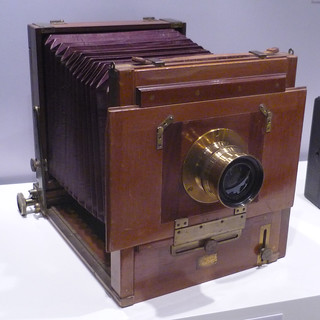Stegemann

|
| Reisekamera (c 1900) Deutsches Technikmuseum Berlin image by Danipuntocom (Image rights) |
| Camera industry in Berlin |
| Agfa | Amigo | Astro Berlin | Bermpohl | Bopp | B+W | Foth | Goerz | Grass & Worff | Levy-Roth | Ernst Lorenz | Plasmat | Rudolph | Rothgiesser & Schlossmann | Rüdersdorf | Schulze & Billerbeck | Sida | Stegemann | Romain Talbot |
A. Stegemann was a maker of cameras in Berlin, from the late 19th century until at least 1950.[1]
The company made cameras of several types, some of which are somewhat innovative in design. The cameras include several variations on the Hand-Kamera; a strut-folding camera for hand-held use, with a focal-plane shutter and unpleated leather bellows, and with a folding frame or Newton-type viewfinder. The original of this series was the Geheim-Kamera (secret camera) of about 1893.[1] The Hand-Kamera was made from about 1895 in several plate sizes, for mono- and stereo- photography.[2][3][4][5]
Stegemann also made some folding bellows cameras,[6][7][8][9] and box-form reflex cameras in several sizes.[10] The cameras have stained wooden bodies (i.e. not leather-covered). McKeown states that these cameras were made from about 1905 until the early '30s;[1] however, the Westlicht auction-listing for the example cited dates it to about 1895.
Stegemann made a 9×12cm monorail camera, the Studien-Kamera (study camera) designed by photographer Heinrich Kühn (who also designed the Imagon soft-focus lens for Rodenstock).[1] This camera has front and rear standards sliding on a wooden rail of triangular section, with a central mount for a stand.[11] It has some movements (front rise and rear tilt and swing) but by no means as extensive as on later monorail cameras. This was made from about 1916 until 1927, when it was replaced with a redesigned model, the Studien-Kamera C[12] The early model has the triangular section of the rail pointing upwards, and the later one has it downwards.[1]
Stegemann also made another 9×12cm studio camera from about 1930, the Tropen-Reise-Studiokamera (Tropical field/studio camera).[13][14] The camera has folding beds at the front and rear, and very long focus, adjustable on both beds. It has front and rear tilt, and front rise and geared shift. It is made in teak with tan bellows and nickel plated metalwork.
Notes
- ↑ 1.0 1.1 1.2 1.3 1.4 McKeown, James M. and Joan C. McKeown's Price Guide to Antique and Classic Cameras, 12th Edition, 2005-2006. USA, Centennial Photo Service, 2004. ISBN 0-931838-40-1 (hardcover). ISBN 0-931838-41-X (softcover). p902-3.
- ↑ 9×12cm Hand-Kamera, about 1895, sold at the eighteenth Westlicht Photographica Auction on 4 December 2010: a strut-folding camera for plates (an early model with wooden strut mechanism), with a focal-plane shutter and frame finder, and front rise, fall and shift. This example has a Carl Zeiss Jena 105mm f/6.5 Anastigmat with helical focusing.
- ↑ 9×13cm Stereo Hand-Kamera, about 1905, sold at the first Westlicht auction on 15 November 2002: a strut-folding plate camera with a focal-plane shutter, similar to the Hand-Kamera cited above, but with more modern metal struts, and with a stereo lens board, with two 120mm f/4.6 Goerz Doppel-anastigmat lenses, with mechanically linked diaphragms.
- ↑ Stereo Hand-Kamera with 112mm f/6.3 Tessar lenses, sold in September 2006 by Auction Team Breker in Cologne.
- ↑ 4.5×6cm Liliput, about 1915, sold at the 20th Westlicht auction on 12 November 2011: a later strut-folding model very similar to the Hand-Kamera. This example has an Emil Busch 7.5cm f/3.1 Glaukar anastigmat with helical focusing. If held as shown in the photograph, it has front shift but not rise.
- ↑ 13×18cm (5×7 inch) Tailboard camera, about 1895, usable for normal or, by exchanging the lensboard, stereo photography. Front rise and shift. Sold at the Eighth Westlicht Auction on 27 November 2005.
- ↑ Another 13x18cm tailboard camera, about 1910, with a stereo lensboard equipped with 13.5cm f/6.3 CZJ Tessars in a Stereo Compound shutter, sold at the 22nd Westlicht auction on 24 November 2012.
- ↑ 18×18cm (7×7 inch) Studio camera, about 1900, with Voigtländer Collinear III No.9 f/7.7 lens, sold in October 2011 by Auction Team Breker in Cologne.
- ↑ Tailboard camera for three-colour photographs (early colour process with three simultaneous exposures through red, green and blue filters), with three Goerz Double-anastigmat lenses; in the 'previous auction highlights' page at Auction Team Breker.
- ↑ Box-form 9×12cm SLR camera in stained wood (not leather-covered), with 16.5cm f/3.5 Steinheil anastigmat and focal plane shutter, with front rise; sold at the nineteenth Westlicht auction on 28 May 2011.
- ↑ Studien-Kamera sold at the nineteenth Westlicht auction.
- ↑ Studien-Kamera C with 120mm f/9 Meyer Weitwinkel-Aristostigmat, sold at the 24th Westlicht auction, on 23 November 2013.
- ↑ 9×12cm Tropen-Reise-Studiokamera, sold at the first Westlicht auction.
- ↑ Another example of the Tropen-Reise-Studiokamera (or perhaps the same camera sold again), with a 25cm f/8 Doppel-Plasmat lens and dial-set compur shutter, sold at the eleventh Westlicht auction, on 26 May 2007 (more photographs).